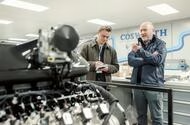Nestled within the unassuming confines of Northampton’s St James Industrial Estate, Cosworth Engineering stands as a beacon of automotive innovation and heritage. This British company, once a household name in motorsport, has re-emerged as a powerhouse in the realm of high-performance engines, particularly for hypercars. With a history steeped in racing, Cosworth has evolved from its grassroots beginnings to become synonymous with some of the most revered performance vehicles of the late 20th century.
The Origins of a Legend
Founded by Mike Costin and Keith Duckworth in the late 1950s, Cosworth’s journey began at Lotus Engineering, where the duo’s passion for motorsport ignited a legacy that would shape the automotive landscape. Their most notable achievement? The DFV V8 engine, which became the most successful engine in Formula 1 history. This pivotal moment not only established Cosworth as a leading engine supplier but also laid the groundwork for its future endeavors in performance car engineering.
Fast forward to today, and Cosworth’s portfolio includes collaborations with luxury brands like Bugatti and Aston Martin, crafting engines that are not just components but integral pieces of art. Chris Willoughby, the company’s commercial director, has been with Cosworth for over three decades, witnessing the evolution of the automotive industry firsthand. He emphasizes that while the company’s focus has shifted, its core ethos remains unchanged: agility and innovation are paramount.
The Artistry of Engine Design
What sets Cosworth apart in the modern automotive landscape is its commitment to creating engines that are celebrated for their beauty and performance. Willoughby notes that today’s hypercars are not merely machines; they are masterpieces that evoke emotion. The aesthetic appeal of an engine, from its intricate components to its robust design, is increasingly appreciated by enthusiasts and collectors alike. This shift in perception highlights a growing interest in the technical marvels that power these extraordinary vehicles.
As the automotive world grapples with the transition to electric vehicles, Cosworth is carving out a niche by continuing to develop powerful combustion engines. The allure of a roaring V12 or V16 engine resonates deeply with car aficionados, as it embodies a visceral experience that electric motors simply cannot replicate. Willoughby points out that even as mainstream manufacturers pivot towards electrification, the demand for high-capacity, naturally aspirated engines remains strong among luxury car buyers.
Navigating the Future of Combustion
While the automotive industry faces increasing pressure to decarbonize, Cosworth is exploring innovative solutions to keep combustion engines relevant. The company has been experimenting with synthetic fuels, which offer a promising alternative to traditional gasoline. Willoughby explains that these synthetic fuels can perform identically to their fossil-fuel counterparts, making them an attractive option for high-performance applications.
Moreover, Cosworth is investigating hydrogen as a potential fuel source for its engines. Although hydrogen presents challenges—such as storage requirements and infrastructure development—its ability to produce comparable power outputs to gasoline makes it a compelling avenue for future exploration. Willoughby emphasizes that while the company is not rushing to commercialize hydrogen technology, it is essential to remain prepared for any eventuality in the rapidly changing automotive landscape.
The Sound of Performance
One of the most captivating aspects of Cosworth’s engines is their sound. Willoughby describes the auditory experience of a naturally aspirated engine as deeply rooted in human psychology. The roar of a high-revving engine can evoke emotions and create a connection that transcends mere mechanics. This connection was evident at events like the Goodwood Festival of Speed, where the thunderous notes of the Aston Martin Valkyrie left spectators in awe.
As the automotive world evolves, the challenge remains to preserve the essence of what makes these engines special. Cosworth’s engineers are dedicated to ensuring that the visceral thrill of combustion engines continues to resonate with future generations. The roar of a V12 or V16 is not just a sound; it’s a celebration of engineering excellence and a reminder of the passion that drives the automotive industry.
In a time when the future of combustion engines seems uncertain, Cosworth stands firm in its commitment to innovation and artistry. The company is not merely resisting change; it is adapting and preparing for a future where the roar of its engines can still be heard, echoing through the annals of automotive history.
The big takeaway? The future of high-performance engines isn’t about perfection—it’s about smarter adjustments. Start with one change this week, and you’ll likely spot the difference by month’s end.

